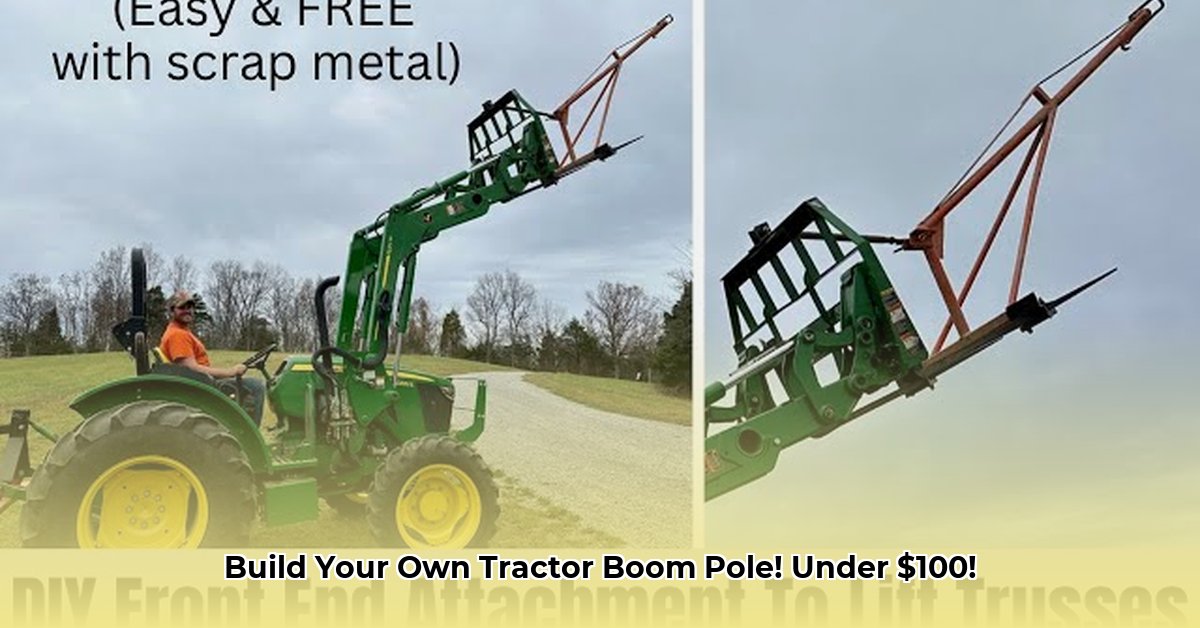
Building Your Own Tractor Bucket Boom Pole: A Step-by-Step Guide
Tired of expensive attachments for your tractor? Building your own boom pole is a cost-effective way to add versatility to your farming or construction tasks. This guide provides a detailed, step-by-step approach to constructing a sturdy and safe boom pole for under $100, enhancing your tractor's lifting capabilities. We'll cover materials, construction, safety, and troubleshooting, so you can confidently build your own boom pole. For more tractor attachment ideas, check out the Compact Tractor Front Loaders page.
Essential Tools and Materials
Before you begin, gather the following items. Prices may vary, so shop around for the best deals.
- 10 feet of 2" x 2" x 1/4" square steel tubing (available at [link to online retailer] or your local metal supplier). Thicker tubing is recommended for heavier loads.
- A receiver hitch adapter compatible with your tractor.
- Assorted bolts, nuts, and washers (various sizes will be needed).
- A heavy-duty safety chain or cable (at least 15 feet; your backup safety system).
- Measuring tape.
- Drill with appropriate drill bits.
- Welding machine (highly recommended; strong welds are crucial for safety). Heavy-duty bolts can be used as an alternative, but welding provides superior strength and durability.
- Angle grinder with a cutting disc (optional, but highly recommended for clean cuts).
- Safety glasses and work gloves.
Step-by-Step Construction: A Practical Guide
Follow these steps carefully to ensure a safe and functional boom pole:
Precise Measurement and Cutting: Measure the desired length of your boom pole carefully, considering the height you need to lift objects. Using an angle grinder makes clean, accurate cuts. A hacksaw can be used, but it's more time-consuming and less precise. Safety First: Always wear safety glasses and gloves when using power tools.
Secure Attachment to Tractor: Attach the square tubing to your tractor's receiver hitch using the appropriate adapter and fasteners. Double-check that all connections are tight and secure to prevent movement during operation. Overtightening can damage threads; use caution.
Reinforce with Support (Highly Recommended): For maximum stability, especially when lifting heavier loads, weld additional support structures. Angle iron is highly effective for this purpose, reinforcing the connection to the hitch. If welding isn't an option, utilize extra-long, high-quality bolts with lock washers for secure fastening. Without adequate bracing, the boom can bend under stress.
Critical Safety Chain/Cable Attachment: Attach the safety chain or cable from the end of the boom pole to a secure point on your tractor. This is your crucial backup safety measure in case of unexpected failure. This chain is not optional; it's a critical safety feature.
Initial Testing (Start with Light Loads): Begin lifting light objects to test the functionality and stability of your boom pole. Gradually increase the weight, always remaining well within the estimated safe working load. Never overload the boom.
Refinement and Adjustment: After testing, assess the design; are there loose bolts? Does it feel sturdy? Can you add further bracing? Fine-tuning will enhance your boom's performance and longevity.
Safety Considerations: Your Top Priority
Remember, safety is paramount when working with heavy equipment. Always:
- Wear safety glasses and gloves.
- Never exceed the boom's safe working load; always err on the side of caution.
- Thoroughly inspect the entire structure before each use, checking for cracks, loose bolts, or any signs of damage.
- Ensure the area around you is clear of obstacles and people.
- Operate your tractor with extreme caution when the boom pole is attached.
Troubleshooting Common Problems
- Bending Boom: If the boom bends under load, you need stronger materials (thicker tubing) or increased bracing.
- Loose Connections: Regularly check bolts for tightness. Loose connections are dangerous and must be addressed immediately.
Weighing the Pros & Cons
| Advantages | Disadvantages |
|---|---|
| Significantly lower cost than a commercial boom | Requires DIY skills and tools |
| Customization for your specific needs | Structural integrity depends on proper construction |
| Great sense of accomplishment | Requires careful attention to safety procedures |
| Increased tractor versatility | May require additional fabrication tools (welder) |
Building your own boom pole offers significant cost savings and increased tractor functionality. By following these instructions carefully and prioritizing safety, you can create a valuable and long-lasting tool for your farming or construction project. Remember, proper construction and regular maintenance are key to ensuring safety and maximizing your boom pole's effectiveness.